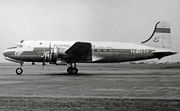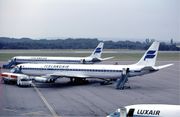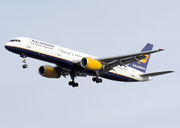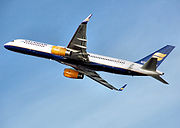Icelandair
 |
||||
|
||||
| Founded | 1937 | |||
|---|---|---|---|---|
| Hubs | Keflavík International Airport | |||
| Frequent-flyer program | Saga Club | |||
| Member lounge | Saga Lounge | |||
| Fleet size | 22 (+4 orders) | |||
| Destinations | 24 | |||
| Parent company | Icelandair Group | |||
| Headquarters | Reykjavík, Iceland | |||
| Key people | Birkir Hólm Guðnason, CEO | |||
| Website | www.icelandair.com | |||
Icelandair is the flag carrier airline of Iceland, based on the grounds of Reykjavík Airport in Reykjavík.[1] It is part of the Icelandair Group and operates services to 25 cities in 12 countries on both sides of the Atlantic. Its main base is Keflavík International Airport.[2]
Contents |
History


Icelandair traces its roots to 1937 when Flugfélag Akureyrar was founded in Akureyri on the north coast of Iceland. Operations started in 1938 with a Waco YKS-7 floatplane. In 1940, the company moved its headquarters to Reykjavík and changed its name to Flugfélag Íslands. A company called Loftleiðir had been formed by three pilots in 1944. Initially, Loftleiðir and Flugfélag Íslands concentrated on Icelandic domestic air services.
In 1945, Flugfélag Íslands (Iceland Airways Ltd) made its first international flights to Scotland and Denmark. International services were commenced in 1946 with converted B-24 Liberator aircraft leased from Scottish Airways. Loftleiðir began scheduled international operations in 1947 and from 1948 used Douglas DC-4 Skymasters. Its pioneering low-fare services across the North-Atlantic commenced in 1953. At the time, IATA determined the fares for airlines flying between Europe and North America, and all airlines charged the same amount. Loftleiðir was not a part of IATA and could, therefore, determine its own fares, undercutting all competing airlines. This made them a popular hub for travel between Europe and North America.
Flugfélag Íslands and Loftleiðir were merged in 1973 and the name Flugleiðir was adopted. The company's English name became Icelandair. A large portion of the air traffic between the United States to Europe flies over Iceland making the island a transfer point for people travelling between the U.S. to Europe and vice versa. This accounts for much of the company's passenger traffic. Icelandair's stopover plan dates back to when Loftleiðir started the plan in 1963 on its transatlantic flights at no extra cost. At the time, Loftleiðir was the only airline that did this and, therefore, pioneered sixth freedom rights. Early sixth freedom flights operated to Findel airport in Luxembourg. That airport was eventually dropped in 1999 in favor of service to more populous cities in Europe. In 1996, Icelandair entered into an interline and marketing agreement with low-fare carrier, Southwest Airlines.[3] This allowed Southwest to carry American passengers destined for Europe. The agreements are no longer in effect.
After the merger, Icelandair was the holding company for the two airlines, but assumed all operating responsibilities in October 1979. In 1997, it established a subsidiary, Air Iceland, to operate domestic and selected short-haul routes. In January 2002, Flugleiðir-Icelandair Group became a holding company with 11 subsidiaries, of which Icelandair is the largest. In March 2005, the group's name was changed to FL Group. In October 2005, FL Group sold its airline and travel operations and a new company, Icelandair Group, was formed. Icelandair has 2,565 employees (as of March 2007).[2]
During April 2010 Icelandair temporarily moved their base of operations from Keflavik to Glasgow Airport due to volcanic activity in Iceland forcing the closure of many Icelandic airports.
In-flight Service

Icelandair's in-flight magazine, Atlantica, is printed six times a year in English. First published in 1967, Atlantica is the second-oldest in-flight magazine in the world. The magazine, produced by the same staff that creates Iceland Review, normally features one or two travel features on Icelandair destinations as well as other articles including interviews, trend stories and profiles.[4]
The in-flight entertainment system comprises seatback, touch-screen monitors for each passenger. The entertainment selection normally includes on-demand movies and television episodes, as well as documentaries and music. The airlines originally charged a fee to access content when the service was first introduced in late 2008, but the fee was discontinued when the service failed to generate income.
The cabin is divided into three classes: economy, economy comfort and Saga class (generally considered equivalent to business class amenities). All classes receive free in-flight meals except for economy, where food and alcohol are offered for a fee but soft drinks are complimentary.
Destinations
Icelandair transported over one-and-a-half million passengers in 2005 (1,526,241), the largest number of passengers that the airline has transported in one year. The number of passengers increased 14.5 per cent from the previous year and, since 1993, this amount has tripled. On average, Icelandair operated 28 flights a day in 2005.[5].
Fleet
The Icelandair fleet includes the following aircraft (at 14 September 2009): [6]

| Aircraft | In Service |
Orders | Options | Notes |
|---|---|---|---|---|
| Boeing 757-200 | 14 | 0 | 0 | |
| Boeing 757-200PF | 5 | 0 | 0 | |
| Boeing 757-300 | 1 | 0 | 0 | |
| Boeing 767-300ER | 2 | 0 | 0 | 1 operating for Travel Service 1 stored at MIA |
| Boeing 787-8 | 0 | 4 | 3 | Entry into service: 2010 |
| Total | 22 | 4 | 3 |
On February 28, 2005, Icelandair signed a contract for two Boeing 787s for delivery in 2010 and purchased rights for five more. On April 5, 2006, Icelandair signed a contract to exercise two of their five Boeing 787 purchase rights for delivery in 2012.
Icelandair shares many of these aircraft with its sister company Loftleiðir Icelandic. Loftleiðir Icelandic is now operating 6 Boeing 757-200s and 2 Boeing 767-300s. Icelease, another sister company of Icelandair, owns 15 Boeing 737-800s. These aircraft were leased to other companies including Air China and Hong Kong Airlines until the 2008 Summer Olympics in Beijing ended.
Icelandair has 3 aircraft on lease to Yakutia Airlines in Siberia, all are 757-200.
Previously operated
- Loftleiðir Icelandic was the sole operator of the Canadiar CL-44J, a 189 seat turboprop aircraft.
- The first turbo-jets Icelandair acquired for their international routes were Douglas DC-8-63CFs, when the airline was still operating as Loftleiðir Icelandic and Boeing 727s as Flugfélag Íslands. The DC-8-63CF fleet was acquired from Seaboard World Airlines of the US. After the merger of the two, both types were used, but during the 1990s, they started acquiring their current fleet of Boeing 757s, along with Boeing 737s that have now been phased out of operation.
- Icelandair used a McDonnell Douglas DC-10 from 1978 to 1979 under the registration N1035F. The Trijet was later used by Air Florida and then with FedEx where it is still in use.
- When Flugfélag Íslands began international flights from Iceland, it used a Consolidated Catalina flying boat.
- Former Icelandair subsidiary International Air Bahama, acquired in the early 1970s, which operated a single Douglas DC-8-63CF between Nassau, Bahamas and Luxembourg. With six weekly rotations, this aircraft became one of the most utilized in the world. East-bound flights were usually made non-stop, but the then-short runway at Luxembourg almost always mandated fuel stops at either Shannon, Ireland or Santa Maria, Azores for west-bound flights. Keflavik, Iceland and Goose Bay, Labrador, were also used very infrequently, depending on the computer flight plan. International Air Bahama was discontinued when airfares from Miami - where most of its traffic originated - dropped to near-Nassau levels, to more major European cities like Brussels, Belgium; Amsterdam, Netherlands and Frankfurt, Germany.
1970
| Aircraft | Total | Orders | Notes |
|---|---|---|---|
| Boeing 727-100 | 1 | 0 | |
| Douglas DC-3 | 2 | 0 | |
| Douglas DC-6B | 2 | 0 | |
| Fokker F27 | 2 | 0 | |
| Vickers Viscount 700 | 1 | 0 | |
| Total | 8 | 0 |
Accidents and incidents
- On 14 April 1963, Vickers Viscount TF-ISU crashed on approach to Oslo-Fornebu Airport. All 12 people on board were killed.[8]
In popular culture
- An Icelandair Boeing 757 aircraft was featured in a scene of the 3-D movie Journey to the Center of the Earth.
References
- ↑ "Icelandair Group." Icelandair. Retrieved on 4 February 2010.
- ↑ 2.0 2.1 "Directory: World Airlines". Flight International: p. 92. 2007-04-03.
- ↑ Southwest links with Icelandair - Baltimore Business Journal:
- ↑ Heimur útgáfufyrirtæki, Atlantica magazine
- ↑ Icelandair 2005 Annual Report
- ↑ Icelandair Fleet - CH-Aviation
- ↑ Flight International 26 March 1970
- ↑ "Accident description". Aviation Safety Network. http://aviation-safety.net/database/record.php?id=19630414-0. Retrieved 6 October 2009.
External links
|
|||||||
|
||||||||||||||||||||||||||||||||||||||||||||||||||||||||||||||||||
|
|||||